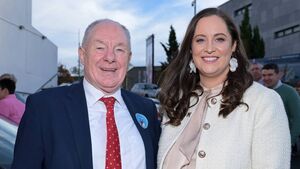Groundbreaking election for women in Mayo

Fine Gael's new TD in Mayo Keira Keogh pictured with her predecessor and mentor Michael Ring outside the TF Royal Theatre in Castlebar last Sunday. Picture: John Corless
Never have there been as many strong, capable female candidates in Mayo as in this election.
At various stages of the campaign, each of the four women in the field were tipped to take seats and in the end, the performance of two of them was historic.
In a weekend where the battle for the last two seats was what engaged and fascinated those at the count centre in the TF Royal Theatre, the performance of Deputy Rose Conway-Walsh can easily be overlooked.
But make no mistake – it was a serious display by the Ballycroy native. She proved 2020 was no flash in the pan and cemented her status as a TD of high regard in this county.
She made history as the first woman to ever top the poll in Mayo. She was also the first TD elected in Mayo in this election – surpassing the quota on Sunday morning.
She was elected in 2020 on the back of a Sinn Féin surge. She took an incredible 14,633 first preference votes to be elected on the first count, narrowly missing out on topping the poll by the indefatigable Michael Ring. Many asked if she could she repeat that display.
It is one thing to be elected on the promise of what you will do for the people of your county, it is another thing returning before the electorate almost five years later to see if your work can cash the cheque your promises wrote.
It was clear that Conway-Walsh had impressed the people of Mayo across her first Dáil term when you look at her vote. Without the same surge in Sinn Féin support nationally, the party vote in Mayo – she had Cllr Gerry Murray as a running mate this time around – remained relatively constant. Between them they took 13,717 votes, Conway-Walsh taking over 10,000 of them.
Conway-Walsh still polled very strongly across the county, including in Swinford and Claremorris, areas assigned to Murray, and particularly so in the urban centres of Castlebar and Ballina where it was felt that her 2020 vote might be under threat.
She was delighted with her performance at the count centre and her election on Sunday morning was an emotional one for her and her family, with thoughts of her late brother Colum, who died last year, foremost in their minds.
She looks like she now has the voter appeal to be a TD for several elections to come.
Few saw Keira Keogh taking a seat a few months ago. Once Michael Ring said he wasn’t running, the focus turned to her, and people questioned how someone who was not elected to Mayo County Council could be elected to the Dáil six months later. We’ve written about that elsewhere in these pages, but there is no doubt Keogh taking the seat is an incredible display. She can thank Michael Ring for a great deal of that but she performed well in the election and came across as personable and warm.
Now she is a TD, she will have to demonstrate her work rate and ability but before you can do that, you need to get elected. To do so means you have to connect with the electorate and Keogh did that. The drive in Westport to keep a TD was very much a factor too.
Keogh’s election, on the back of Conway-Walsh’s, is historic too. It means there are two female TDs in Mayo for the first time ever which is groundbreaking.
Beverley Flynn, in 1997, was the first woman ever elected to Dáil Éireann in Mayo. Keira Keogh is now the fifth woman to be elected to the Dáil from Mayo (after Flynn, Michelle Mulherin, Lisa Chambers and Rose Conway-Walsh).
We need better balance in our political representation. I have written before about the make-up of Mayo County Council being ‘male, pale and stale’. It is no slight on any particular candidate, more of a general observation.
It is refreshing to see plenty of young, capable candidates – both male and female – standing in this election.
Indeed, there was considerable belief before the weekend that there might even be three female TDs. Lisa Chambers was backed by many commentators – this writer included – to take a seat but politics is an unforgiving game, and now many will be writing her political obituary.
She needed to increase her vote from 2020. Instead, despite a larger constituency and the absence of Michael Ring in the field, her vote dropped.
Chambers came from nowhere in 2011 to poll respectably for a first-time candidate when Fianna Fáil were on the floor. She took a county council seat in 2014 and a Dáil seat in 2016 and her star was certainly on the rise. At national level, she was a very capable performer and had senior ministerial potential.
However, there was a feeling, rightly or wrongly, that she wasn’t as good a constituency TD as some of her rivals and many is the prominent national politician that has died on that particular sword.
With Enda Kenny retiring in 2020, retaining her seat should have been well within Chambers’ compass but she lost out to an unproven, though high-profile, rival in Alan Dillon. She was elected to the Seanad and kept a decent profile, though sometimes that was not to her advantage.
She found herself on the wrong side of a couple of controversies over the years, not least canvassing for a yes vote in last spring's family referendum only to bizarrely confess to voting no in the aftermath.
But there was a strong feeling that if she was elected this time around, she would go straight to a senior cabinet position. Fianna Fáil are not blessed with many high-level female performers. You only have to look at Norma Foley’s struggles in Education to realise that.
Chambers could not say this herself before the election but perhaps it is something her team could have made sure was loud and clear to the electorate. Be that as it may, we are not sure if it would have salvaged her vote sufficiently.
In the run-up to the election, she made it known that this was her last shot at it. She is a barrister by profession and there is only so long she can have that career on ice pursuing a route back to the Dáil.
The analysis of why she could not get in across the last two elections may be multi-faceted but, ultimately, when she could not be returned in 2020 as a sitting TD with Enda Kenny departing and then this time around with no Michael Ring and, in effect, two seats up for grabs, it is apparent her appeal among the electorate is just not at the level it needed to be.
In 2011, she took 3,343 votes and five years later was elected after getting 8,231 votes. But her vote fell steadily from there to 6,373 in 2020 to 5,584 this time and it was soon clear that she was struggling for transfers too.
At 11.34am on Sunday, returning officer Ann Marie Courell eliminated Chambers from the election. Will that be the last time we will hear her name in an election?
It’s a blood sport and Lisa Chambers knows that more than most.
Martina Jennings will begin to realise that now too.
Her campaign never got going. At the time of addition to the Fine Gael ticket being declared, this writer felt she would take a seat. She has a high profile, a track record of delivery with the cystic fibrosis unit in Mayo University Hospital and being the driving force of the Mayo Roscommon Hospice team that delivered two hospice facilities in Castlebar and Roscommon.
But in order to be in the mix for a seat, she had to outperform her local rival and former Fine Gael councillor Patsy O’Brien. She failed, being nearly 2,000 votes behind him on the first count.
There is nothing easy about the game and credit to all four – and the 12 men – for putting themselves before the people.






